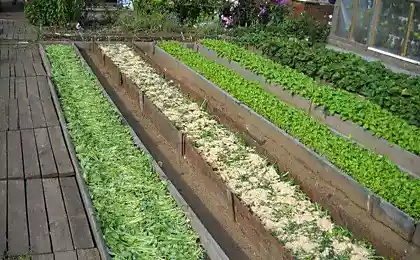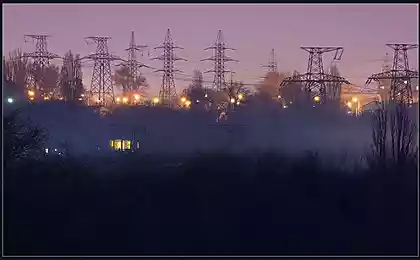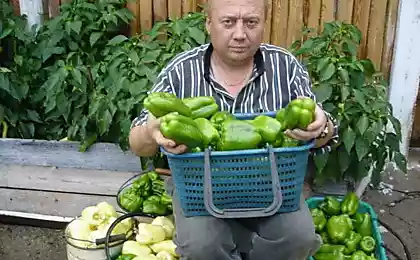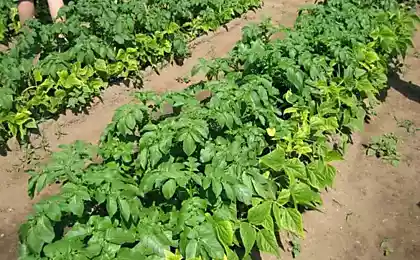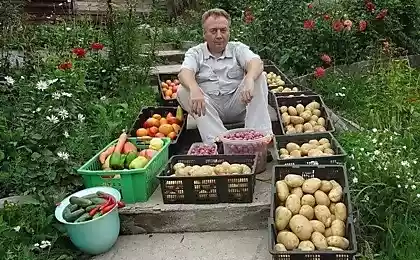695
Vegetable production according to advanced methods. Part 2: Methods of vegetable growing.
Jacob advanced methods offers you two highly efficient method of vegetable to choose from. You have to determine which one is better or you can try both. The use of narrow ridges less costly and easier for beginners. In addition, the vegetables will grow in natural soil, and the ridges are not restricted to certain forms, you can easily fit them into your plot. But growing in the boxes-the furrows, requires more initial work and costs, however, the drawers are very easy to build and use. In addition, such devices can serve you for many years.
Vegetable growing on narrow ridges
Narrow ridge is a narrow strip of land (width 45 cm. long and 9 m.), specially prepared for the production of high yield of vegetables. The length can vary depending on the size of your garden, but the width must always be equal to 45 cm. Along each side of the ridge has a rim height of about 10 cm Internal space between them is 30 to 35 cm, inside the soil carefully leveled. Narrow ridge can be restricted by borders not only with lateral, but also with short sides to prevent water draining from the ridges.
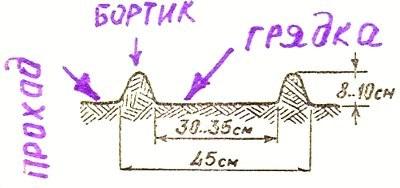
Plants are planted in rows, with the inner side of the bumpers. Depending on the species, they are placed in a row at distances of 7.5 cm, 10 cm, 17.5 cm, 30 cm, 35 cm and 50 cm from each other. Some species are planted in two rows against each other. Other plants that require more space and light is also planted in 2 rows, but staggered. The largest plants are planted only along one side of a narrow ridge.
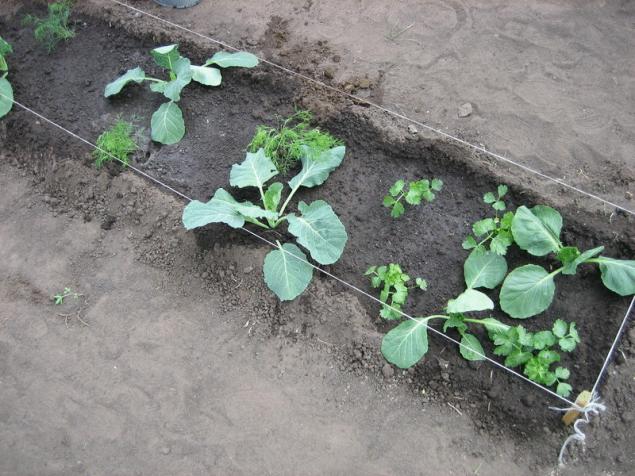
Fertilizer is placed in the center of narrow ridges, filling them with a thin strip on the surface of the soil in the 7.5 — 10 cm from the plants, so they will not hurt and will not cause burns. Before this procedure, plants should be watered.
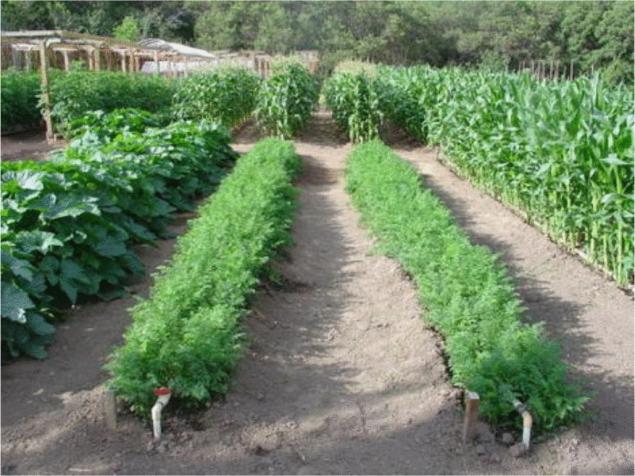
In the garden, made by advanced methods, a lot of the area is not planted and is used to make large passages between the ridges, ideally they should be a width of 105 cm., you can reduce (but not less than 60-75 cm) in that case, if you have little space. If you have little space, the width of the passages between the ridges can be slightly reduced. When growing plants, require large space, for example, pumpkins or watermelons, the aisle width should be increased to 2.5-3 m, And be directed to the growth of lashes.
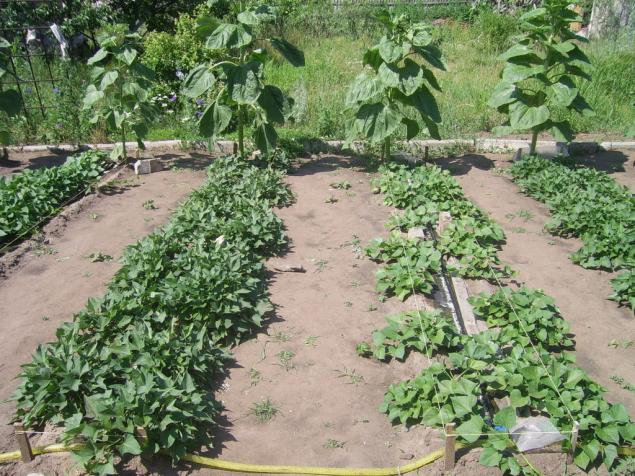
Watering should only ridge, so you can simplify the problem of weeds in the aisles and save water. Soon, you will notice that weeds do not grow in the midst of narrow ridges, this is due to the increased concentration of salts in place of fertilizer. When you water the ridges, avoid using sprinkler systems. Water, except rainwater should not fall on the leaves of plants. Water narrow ridge at the level of the soil and roots. This prevents the development of mold and reduce water consumption.
The advantages of using narrow ridges
Method of vegetable growing on narrow ridges on the advanced methods combines the best features of vegetable growing in natural soil and hydroponics. This perfect, foolproof method is simple to implement, eliminates the guesswork and ensures success nearly everywhere, almost all types of hard soil.
The benefits of gardening on the narrow ridges are:
1. The most complete use of time, area and resources
You only need a few hand tools such as shovel, rake and a watering hose. The method significantly reduces the time and effort that people spend on a weeding, affordable, as fertilizers and everything needed for growing vegetables for minimal cost and easily accessible. With appropriate training normal people are able to create a totally unique kitchen gardens.
2. High yields
The abundance of vegetables you can get on any type of soil, anywhere in the world. Success is guaranteed as to chance nothing left. Plants provide additional food minerals, as in hydroponics, but without the use of special equipment. Unlike hydroponics, method of growing on narrow ridges provides plants access to nutrients that are in natural soil.
3. Proper nutrition of plants
A mixture of fertilizers made recipes Dr advanced methods eliminate the guesswork in the production of beautiful, healthy vegetables.
4. Economical use of water
Water is available to plants only in the root layer. That is, you do not drop waste and use fewer.
5. Protection from adverse weather conditions
Narrow ridge it's easy to cover up, building a miniature greenhouse that protects plants from cold winds, snow and rain. Small shelter lengthen the growing season and extend the harvest period.
Vegetable gardening in boxes-the ridges
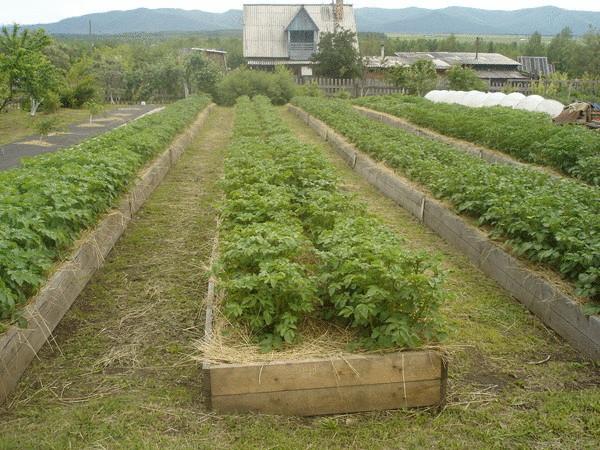
Boxes-ridge represent devoid of the bottom of the frame, which is used to enclose small plots of land. Frames are usually made of wood or cement, build directly on-site and set in a horizontal position. Boxes-ridge filled artificially made "homemade soil", which is a mixture of sawdust and sand, or a combination of other inert and organic materials with balanced fertilizer. An artificial soil mix in the boxes-use the ridges year after year, never changing and not thrown away.
For the construction of frames for boxes, ridges, you can use various suitable materials:

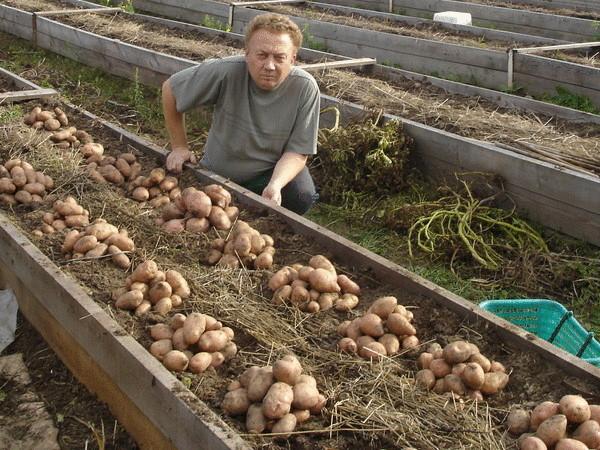
For wood do not use creosote, it retains toxicity for many years. Old railway sleepers can be used as the creosote in them is not toxic. Boxes-the ridge are filled with different materials, both organic and synthetic. Generally a mix of 2-3of NeupreisLenno material (natural soil to fill the boxes not used):
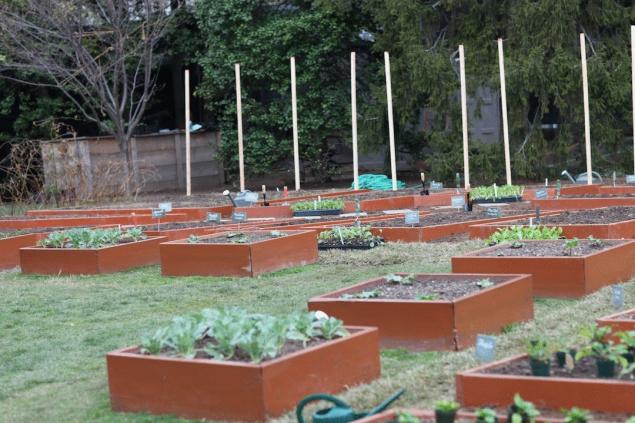
Boxes-ridge can be of any length and width, but most people use either "mini" boxes, a width of 45 cm or "standard" drawers width 150 cm Doctor advanced methods believes that the ideal width is 120 cm., since these boxes are best suited to automatic irrigation systems. However, the drawers-ridge can be of any sizes suitable for your needs and conditions. The main thing is to install them horizontally and see that depth in all its parts the same recommended 20 cm Aisles between the boxes, rollers are of 90 cm Distance between the ends of the boxes is 150 cm. If everything build correctly, they reliably serve for many years.
The advantages of the use of the box ridges with artificial potting mix
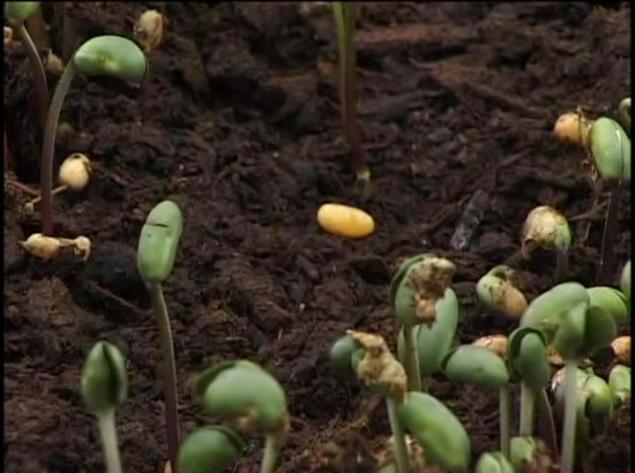
Growing plants in a vertical position
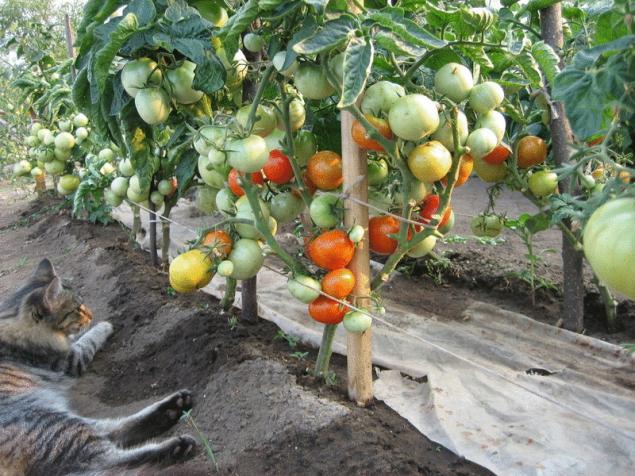
By the method advanced methods plants can be grown both in horizontaland in vertical position. For some types of tool, the swirling around the pillars is natural: for example, curly (Lima) beans and peas, a pumpkin, some other cultures you can force to grow vertically: tomatoes, cucumbers and melons.
Growing crops in a vertical position has a number of advantages:
A vertical crop with stakes
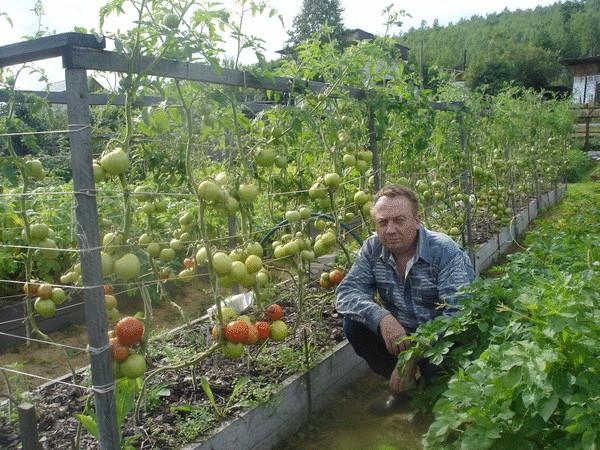
According to the advanced methods there are two ways to grow plants vertically. You can use stakes or can build A-shaped supports. To grow plants vertically, need stakes cross-section of 5x5 cm and a length of 3 m. They hammered into the ground to a depth of 25 cm in one line with a number of plants. The distance between the stakes 75-90 cm According to the growth of the plants the tops of the whips sent between two rows of ropes attached to stakes. The plants themselves do not actually tied to the stakes. The use of stakes, inexpensive and simple method. It increases the factor of light, so important for plant health and also reduces casual labor costs and almost completely eliminates pruning.
After the growing season is over, the stakes are pulled out and stored until next year. Doctor advanced methods stain their stakes in white color to improve their appearance and increase durability
A vertical crop with the help of A-shaped supports
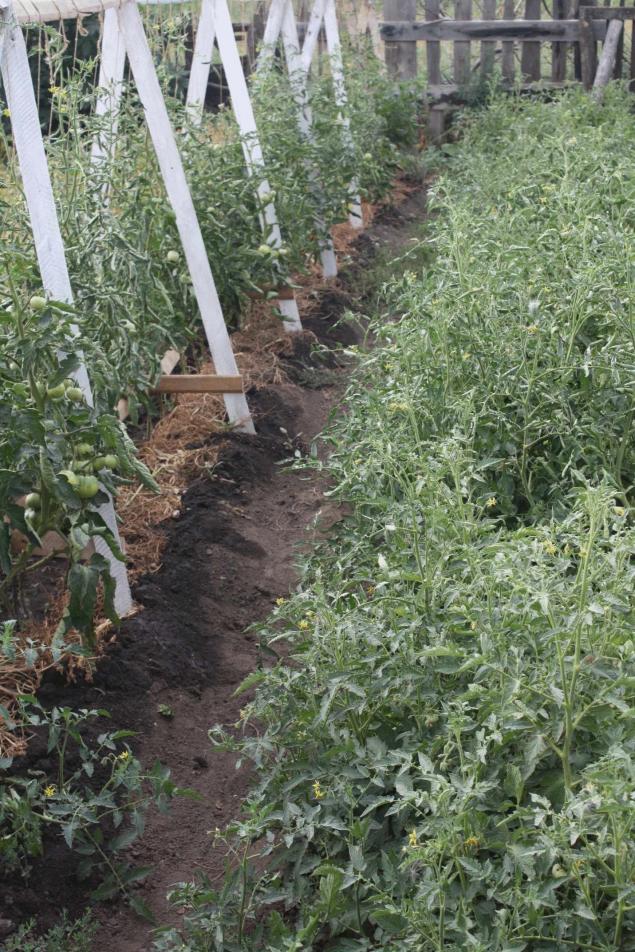
A-shaped supports are erected using poles with cross section 10x10 cm and a length of 3 m. They are fastened, forming the letter “a”. On poles, install cross member with a length of 3 m, which carry the cables that support the plants. Support is usually 3 m in width, length can be any. They are supported by the upper cables (wire), one above each row of plants. To the wire tie a long enough rope, one for each of the ranks.
The advantage of A-shaped supports is that the system, once installed, reliable, fixed and stationary, ready-to-use year after year. This method is ideal for the production for sale of tomatoes, cucumbers and melons. In this method of production plants are usually placed in the garden in two rows.
Source: /users/1
Vegetable growing on narrow ridges
Narrow ridge is a narrow strip of land (width 45 cm. long and 9 m.), specially prepared for the production of high yield of vegetables. The length can vary depending on the size of your garden, but the width must always be equal to 45 cm. Along each side of the ridge has a rim height of about 10 cm Internal space between them is 30 to 35 cm, inside the soil carefully leveled. Narrow ridge can be restricted by borders not only with lateral, but also with short sides to prevent water draining from the ridges.

Plants are planted in rows, with the inner side of the bumpers. Depending on the species, they are placed in a row at distances of 7.5 cm, 10 cm, 17.5 cm, 30 cm, 35 cm and 50 cm from each other. Some species are planted in two rows against each other. Other plants that require more space and light is also planted in 2 rows, but staggered. The largest plants are planted only along one side of a narrow ridge.

- Potatoes, corn, radishes, onions, turnips, beets and lettuce are placed on narrow ridges two rows.
- Iceberg lettuce, cabbage, broccoli and other crops of similar size have two rows in a staggered manner.
- Tomatoes, melons and other crops requiring a lot of space, are arranged in one row along one of the sides of the narrow beds.
Fertilizer is placed in the center of narrow ridges, filling them with a thin strip on the surface of the soil in the 7.5 — 10 cm from the plants, so they will not hurt and will not cause burns. Before this procedure, plants should be watered.

In the garden, made by advanced methods, a lot of the area is not planted and is used to make large passages between the ridges, ideally they should be a width of 105 cm., you can reduce (but not less than 60-75 cm) in that case, if you have little space. If you have little space, the width of the passages between the ridges can be slightly reduced. When growing plants, require large space, for example, pumpkins or watermelons, the aisle width should be increased to 2.5-3 m, And be directed to the growth of lashes.

Watering should only ridge, so you can simplify the problem of weeds in the aisles and save water. Soon, you will notice that weeds do not grow in the midst of narrow ridges, this is due to the increased concentration of salts in place of fertilizer. When you water the ridges, avoid using sprinkler systems. Water, except rainwater should not fall on the leaves of plants. Water narrow ridge at the level of the soil and roots. This prevents the development of mold and reduce water consumption.
The advantages of using narrow ridges
Method of vegetable growing on narrow ridges on the advanced methods combines the best features of vegetable growing in natural soil and hydroponics. This perfect, foolproof method is simple to implement, eliminates the guesswork and ensures success nearly everywhere, almost all types of hard soil.
The benefits of gardening on the narrow ridges are:
1. The most complete use of time, area and resources
You only need a few hand tools such as shovel, rake and a watering hose. The method significantly reduces the time and effort that people spend on a weeding, affordable, as fertilizers and everything needed for growing vegetables for minimal cost and easily accessible. With appropriate training normal people are able to create a totally unique kitchen gardens.
2. High yields
The abundance of vegetables you can get on any type of soil, anywhere in the world. Success is guaranteed as to chance nothing left. Plants provide additional food minerals, as in hydroponics, but without the use of special equipment. Unlike hydroponics, method of growing on narrow ridges provides plants access to nutrients that are in natural soil.
3. Proper nutrition of plants
A mixture of fertilizers made recipes Dr advanced methods eliminate the guesswork in the production of beautiful, healthy vegetables.
4. Economical use of water
Water is available to plants only in the root layer. That is, you do not drop waste and use fewer.
5. Protection from adverse weather conditions
Narrow ridge it's easy to cover up, building a miniature greenhouse that protects plants from cold winds, snow and rain. Small shelter lengthen the growing season and extend the harvest period.
Vegetable gardening in boxes-the ridges

Boxes-ridge represent devoid of the bottom of the frame, which is used to enclose small plots of land. Frames are usually made of wood or cement, build directly on-site and set in a horizontal position. Boxes-ridge filled artificially made "homemade soil", which is a mixture of sawdust and sand, or a combination of other inert and organic materials with balanced fertilizer. An artificial soil mix in the boxes-use the ridges year after year, never changing and not thrown away.
For the construction of frames for boxes, ridges, you can use various suitable materials:

- Treated lumber (treated wood lasts longer than untreated).
- Cement (especially practical in areas where there are termites).
- Small, smooth timber (e.g. pine or eucalyptus logs).
- Old railway sleepers

For wood do not use creosote, it retains toxicity for many years. Old railway sleepers can be used as the creosote in them is not toxic. Boxes-the ridge are filled with different materials, both organic and synthetic. Generally a mix of 2-3of NeupreisLenno material (natural soil to fill the boxes not used):
- Sawdust
- Sand
- Sphagnum moss
- Perlite
- Pine bark
- Granules styroform (insulating foam)
- Crushed coconut husks
- The crushed shell of walnuts
- Pumice

Boxes-ridge can be of any length and width, but most people use either "mini" boxes, a width of 45 cm or "standard" drawers width 150 cm Doctor advanced methods believes that the ideal width is 120 cm., since these boxes are best suited to automatic irrigation systems. However, the drawers-ridge can be of any sizes suitable for your needs and conditions. The main thing is to install them horizontally and see that depth in all its parts the same recommended 20 cm Aisles between the boxes, rollers are of 90 cm Distance between the ends of the boxes is 150 cm. If everything build correctly, they reliably serve for many years.
The advantages of the use of the box ridges with artificial potting mix

- The success of horticulture in boxes-the ridges does not depend on local soil conditions.
- Boxes-ridge can be built almost everywhere in the cities, on hillsides, in places where very poor soil conditions.
- Boxes-the ridge provide excellent drainage, aeration for roots and balanced nutrition
- In boxes-soil under a layer of fertile soils and natural "subsoil remains moist and soft. This allows the plant roots to penetrate into the natural soil.
- Boxes-ridges lengthen the growing season, since artificial soils warm up quickly in spring, allowing for faster growth.
- Boxes-ridges act as a temperature regulator, since artificial soils the roots cool during the hot summer.
- Boxes-ridges retain water.
- With a balanced mineral nutrition and proper operation on the boxes-the ridges receive high yields of high quality vegetables.
- Vegetable gardening in boxes-ridges requires less space than a vegetable growing on a natural soil.
- In boxes-ridges weeds very little or not at all.
- Boxes-the ridge is easy to handle, because they can be processed from all sides.
Growing plants in a vertical position

By the method advanced methods plants can be grown both in horizontaland in vertical position. For some types of tool, the swirling around the pillars is natural: for example, curly (Lima) beans and peas, a pumpkin, some other cultures you can force to grow vertically: tomatoes, cucumbers and melons.
Growing crops in a vertical position has a number of advantages:
- On a smaller area you can grow more number of plants
- The quality of vegetables is higher because each plant gets more light.
- Plants are easier to feed, water, crop and easier to harvest.
- The fruits do not get sun burn and whip and the leaves are not damaged during harvesting.
A vertical crop with stakes

According to the advanced methods there are two ways to grow plants vertically. You can use stakes or can build A-shaped supports. To grow plants vertically, need stakes cross-section of 5x5 cm and a length of 3 m. They hammered into the ground to a depth of 25 cm in one line with a number of plants. The distance between the stakes 75-90 cm According to the growth of the plants the tops of the whips sent between two rows of ropes attached to stakes. The plants themselves do not actually tied to the stakes. The use of stakes, inexpensive and simple method. It increases the factor of light, so important for plant health and also reduces casual labor costs and almost completely eliminates pruning.
After the growing season is over, the stakes are pulled out and stored until next year. Doctor advanced methods stain their stakes in white color to improve their appearance and increase durability
A vertical crop with the help of A-shaped supports

A-shaped supports are erected using poles with cross section 10x10 cm and a length of 3 m. They are fastened, forming the letter “a”. On poles, install cross member with a length of 3 m, which carry the cables that support the plants. Support is usually 3 m in width, length can be any. They are supported by the upper cables (wire), one above each row of plants. To the wire tie a long enough rope, one for each of the ranks.
The advantage of A-shaped supports is that the system, once installed, reliable, fixed and stationary, ready-to-use year after year. This method is ideal for the production for sale of tomatoes, cucumbers and melons. In this method of production plants are usually placed in the garden in two rows.
Source: /users/1
Vegetable production according to advanced methods. Part 3: Planning a vegetable garden.
Inspiration - Life



